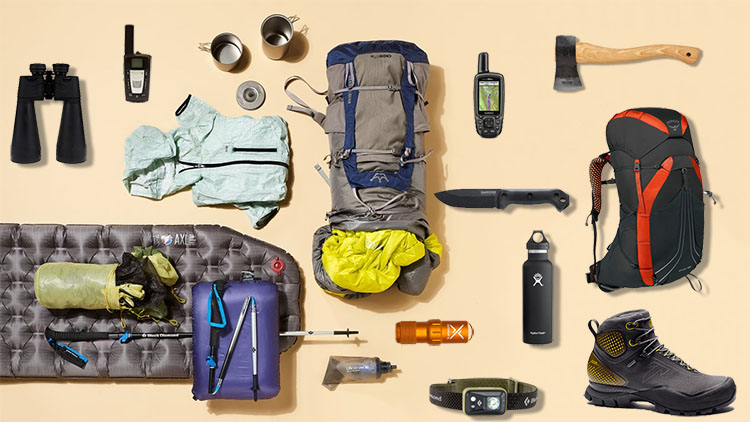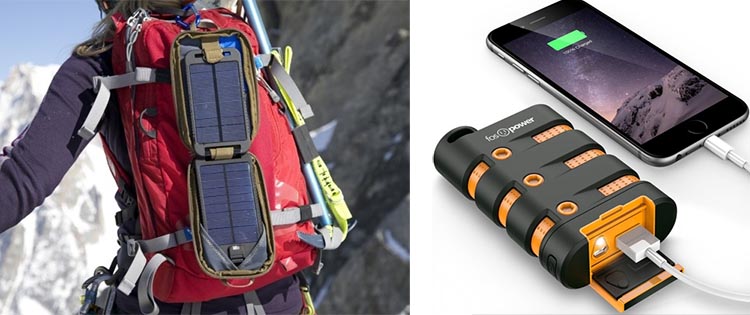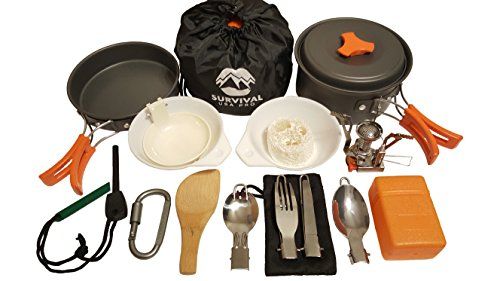
Seasoned hikers know the importance of having the right equipment unfortunately most newcomers struggle to get an idea of what they need. It can be difficult because different hiking trails require different equipment and many newbie’s don’t understand the need for so much equipment. However, having the best hiking equipment will be necessary when you are heading outdoors and you will need to know what you should be taking with you. Here is just a handful of the best hiking equipment you will need.
Page Contents
- The Backpack
- Tents and Sleeping Bags
- Food and Water Supplies
- Lighting
- First-Aid Kits
- Maps, Compasses and GPS
- Waterproof Jackets
- Footwear
- Rain protection
- Sun protection
- Fire/fire source
- Watch
- Navigation equipment
- Portable battery charging equipment
- Solar panel-power source
- Portable battery bank/battery recharger/power bank
- Emergency blanket
- Knife & various supplies
- Trekking poles
- Cooking equipment
- Binoculars
- Don’t Forget the Essentials
The Backpack

Choosing a suitable backpack is crucial when it comes to hiking, however, you don’t just have one or two backpacks to choose from, you have a huge variety. For example, there are day hike backpacks that are suited for shorter hikes; and there are also the weekend and week backpacks along with the summit backpack. Now, depending on how long your hike will be and where you will hike, you need to choose the most suited backpack.
If you plan to go on week-long excursions or arduous trails, you probably are best to stick with the summit backpacks. These are reliable for almost every occasion and even though you may not think they will be needed, they can be useful for any hiker. When you are choosing a new backpack, you want one which is comfortable to wear and very durable so that you are able to pack all necessary equipment.
Tents and Sleeping Bags

Shelter is crucial for hikers because when night comes, they need to have a safe place to rest their heads. A tent is a crucial piece for hikers who plan to spend an evening outdoors and it helps to keep the cold out which is what you need. However, if you are hiking alone, you don’t need a large tent, just one that sleeps one or two people at most otherwise you will carry additional weight you don’t need to. A bivouac or bivy tent is an option to consider as well.

For weekend adventures, you are going to need the very best sleeping bag possible to allow for maximum comfort and sleep time. Sleeping outside may not appeal to a lot of people but it’s a part of the hiking experience. You want to choose a sleeping bag which is light to carry but durable and warm enough for nights and colder weather. Ideally, you want to choose a fleece lined or insulated sleeping bag with a full length zipper. This should help keep you warm throughout the night and allow you to get a good night’s rest.
Food and Water Supplies
You will need to carry a few good gallons of water for hiking because as you walk, you are losing fluids and you need to keep hydrated throughout. Let’s say you were going for a short hike, you should carry at least one or two gallons of water so that you have enough water to keep yourself hydrated. For longer hikes, you are going to need considerably more water and remember you need enough water for the hike and back again.

For food, you will need enough for the trip but you want to pack foods that are light and easy to eat. You don’t want to take items you have to spend a lot of time preparing or cooking because it’ll waste more time than needed. Canned goods are probably best because they are easy to carry and take minutes to cook; and even though it’s not a gourmet meal, it still will be filling. Protein and energy bars always work best for quick snacks just make sure you have enough supplies for each person in your hiking group. Don’t forget to pack a small cooking stove.
Lighting

Even though you aren’t going to be hiking at night, you still need to have some form of lighting. Things such as flashlights, headlamps, lanterns and candles can be very useful because they provide you with simple methods to light your tent at night. Lighting will also be needed for you to find a way to the bathroom during the middle of the night; so don’t forget to stock up on batteries and matches.
First-Aid Kits
Having a first-aid kit can be very useful when it comes to hiking and you will need to carry one of these kits. Hopefully you won’t ever need to fall back on a first-aid kit but you simply never know when it’s needed. It’s important to have a first-aid kit with you; and don’t forget to pack a pocket knife.
Maps, Compasses and GPS

You are out in the wilderness and it means you have to rely on your skills and know-how. Sometimes, it comes down to a map and compass and these are the things you may have to rely on to find your way home. If you don’t pack these, you will get lost because trails can get confusing and you get turned around and end up lost. However, having a compass and map of the area can allow you to find your way back safely.
You should also consider using GPS devices even if you have maps with you. If one should fail, you at least have a back-up option to rely on.
GPS watches can also be an option. Many outdoor watches come with GPS, and models such as the various G-Shock watches come with Triple sensor (altimeter, barometer, compass).
Waterproof Jackets

There are lots of options to consider when it comes to jackets but you want one which is going to be comfortable and durable. Look for hip length jackets which offer wind and water resistance properties. Don’t forget to look for hooded jackets with extended storm flap to keep you warm in harsh weather conditions. A good water repellent jacket may set you back anything between fifty and one hundred dollars but it’ll last a good while nonetheless.
Footwear
It is considerably difficult to narrow down the choice for hiking shoes and favorite hiking sandals because there are lots of varieties out there. The reason why is simple, you’re going to cover a lot of terrain and sometimes, different walking shoes will be needed. If you are going on a light hike, you want to stick with a trail runner shoe that is light but capable of handling most soft conditions.

For tougher terrain a strong hiking boot will be needed. Ankle high boots are perfect for most terrains and ideally you want to choose hiking boots that support the feet. You want durability most of all because you want to protect your feet at all costs. Some of the high-end boots will cost maybe around one hundred if not more but it’s your choice what you are happy to pay out.
The list of hiking equipment that you need to prepare is long but you should always prepare it according to the number of days that you’re going to spend while hiking.
Here are some other things that you’re going to need for a nice hiking experience:
Rain protection
Bringing your waterproof jacket is going to help for sure, but it may not be enough when you have plenty pf thunderstorms throughout the day. When you’re hiking in the high country, more often than not the weather changes dramatically in a blink of an eye. Bring along an effective raincoat for keeping the risk for developing hypothermia really low.
It’s also a wise thing to pack a lightweight tarp and a poncho, along your tent, especially if there’s a slight chance to get trapped in a storm and need a shelter. This is mandatory especially for the summer hiking as summer thunderstorms are so common in some areas. You need to make sure that you’re going to be just fine after a night out. The tent is a great choice but even a tarp can bring some comfort. Put it at the bottom of your backpack. Even an extra jacket may work that way.
Sun protection
No matter when or where you’re going, you should have on you at least one of the three: a hat, sunscreen or sunglasses. You should get at least one of them even if the temperatures at elevation are really low. As a matter of fact, the risk for getting sunburns at high altitude is actually higher than in lower, yet hotter altitude.
Most of us don’t know, but there is an 8-10% increase in UV intensity for every 1,000ft of elevation gain. Wearing sunscreen may feel awkward at high elevation, but you should do it nevertheless. Do it especially if there’s snow on the ground or you’re going to get sunburns in places you never imagined. The sun is reflecting off the snow, increasing the risk for developing sunburns.
Fire/fire source
No matter how long your hiking experience is going to be, you should always have on you some equipment for starting a fire. A pack of matches or a lighter mean nothing for the overall weight of your backpack and you should always put them before hitting the trails. You should have something for fire at all times. remember to keep the matches dependable and store them in a waterproof bag. Some waterproof matches are going to be a solid choice for any hiker.
Carrying some sort of tinder (fire sticks or even some cotton balls soaked in petroleum jelly and stored in a piece of aluminum foil, an old film canister) isn’t a bad idea at all.
Watch
It’s also important to have on you a good watch so that you can make an idea about the speed, the distance remaining and the time you’re going to get back home. Most hikers out there have a 3 miles per hour speed and you should add another hour for every 1,000ft of elevation gain. This rule of thumb was invented by Naismith, a famous 19th century mountaineer.
As we’re all different, it’s better that you time yourself on every hike to discover your very own pace. Keep in mind that the Naismith’s rule doesn’t contain the breaks.

When it comes to backcountry navigation, the modern tools really made the difference. Any hiker is able to get 5 essential tools while hiking: map, altimeter, compass, GPS device and even a personal locator beacon (“PLB”) or any other type of equipment for contacting emergency.
Should you have to go through an emergency, you should have and be able to use any of the aforementioned equipment. If you have them all, that’s even better; it’s going to increase your chances for rescue.
- Maps- they contain an impressive amount of information about a region that you cannot replicate by memory or written description. Any hiker should also have a topographic map stored in a case or a reseal able plastic bag. A map doesn’t break, doesn’t need electricity and offers backup info and the “big picture” about the area you’re hiking. No matter how many other gadgets you may have on you, always carry a printed topographic map as a backup.
- Altimeter- experienced hikers appreciate the importance of knowing the elevation while out there. When you’re using a topographic map and you know the elevation, you’re one step closer to solving the navigation problem, day or night. Sometimes, you only need to know the trail, the bearing, or the stream to find out your place at a time. Altimeters are made of silicon and may measure air pressure or use GPS satellite signals. They can combine the two as well.
- Compass-solid and easy to use, a compass is going to help a hiker orient the map and find his/her way in the wilderness. You should get a compass with a baseplate for measuring and following field bearings, matching them with your map later on. Some wristwatches, smartphones, GPS devices are including electronic compasses nowadays.
- GPS device- the GPS really changed the navigation world, offering the hikers information about their precise location on a digital map. Modern smartphones, while working with a dependable GPS app, may surpass some professional GPS units in terms of accuracy. In addition, they’re a lot easier to use too. Using them along with your downloaded digital maps, phones or tablets you may never get lost when out there. The main downside? You do need electricity and they’re also pretty fragile too. You need to protect them from rain and always carry extra batteries. Taking along a fully charged external battery pack is mandatory. You can also go with the dedicated GPS devices instead of your phone as they’re more rugged and dependable for hiking.
- PLBs and satellite communication- a hiker should be entirely self-reliant and you should at least remember that when planning a hike. However, you cannot control everything out there and sometimes, no first-aid kid or sophisticated equipment is going to be able to save you. PLBs and satellite communicators are going to identify your position by GPS, sending a message with the help pf commercial/governmental satellite networks. This type of equipment is capable to save many out there and any hiker should carry one. Satellite phones are a dependable option in wilderness as opposed to the regular phones.
Portable battery charging equipment

You’re going to need some portable options for recharging your devices when hiking. There are two main categories to choose from:
Solar panel-power source
Solar panels for hiking are typically using a thin film of solar cells which have no glass. This is why they’re flexible, lightweight and really easy to fold. They don’t come with battery storage built-in so they’re only going to charge a device when there is enough sun. their output also depends on the solar panels attached to the battery pack.
Portable battery bank/battery recharger/power bank
Any of them is a high capacity battery with outputs that let you connect the device for charging. You need to charge them from a power outlet at home so that you have power when hiking. You may charge it from a solar panel too, but you need to make sure that the power bank takes it as not all models are solar chargeable.
There are other options to consider (the hand crank type chargers and the heat converters) when hiking. They’re reliable for smaller devices, but you should consider a decent solar panel and a good power bank for anything other than your smartphone.
Emergency blanket
No matter the season you’re going to go hiking, it’s not complicated to throw an emergency blanket in the bottom of your pack. lightweight, affordable and really easy to store, an emergency blanket is going to reflect your body heat right back at you in case of anything goes South. In addition, you can also use it for an emergency lean-to shelter.
Knife & various supplies
Even if a tactical knife may work for most situations, you should pay attention to a multi-use knife that is going to become handy when out there.
Some safety pins, duct tape, nylon fabric repair tape, needle and thread, cordage, plastic buckles, cable ties, webbing and replacement parts for your equipment (tent poles, crampons, stove, water filter) are going to help you while hiking too. A multi-tool is also a desirable thing to have on you.
Trekking poles
Trekking poles work just an extendable arm that is going to maintain your balance. The adjustability, the shaft material (which has a big role in their durability and weight), the grip material, and the shock absorbency are the most important aspects to take under consideration when choosing your trekking poles.
Cooking equipment

It’s only a matter of time until a dedicated hiker is going to take the plunge and start hiking for more than a couple of days. When you’re hiking for several weeks, one thing you have to address is the cooking. From a lightweight stove and the gas lighter (preferably windproof and definitely refillable), the cooking equipment that you should bring along is another matter to learn about. An easy to clean cooking pot and a mug for a hot cup of tea are adding on the list and you should complete it according to your hiking needs.
Binoculars

You never know when a good pair of binoculars is going to become handy on your hiking trip, so you’d better add them to your shopping list. They shouldn’t be heavyweight and it’s best that you check the diameter of the eyepieces (you don’t want the diameter to be too high as they’re going to be thick, which means heavyweight too). Don’t get cheap and buy yourself high-performance binoculars right from the start, as it’s going to worth the extra buck. Your hiking binoculars should also be compact, water tight and easy to store or grab while hiking. Your hiking abilities count a lot when selecting your binoculars so choose wisely.
Don’t Forget the Essentials
If you plan on rock climbing or some other form of activity during hiking you must ensure you have the necessary equipment for this. For example, you need to have lots of climbing rope suitable for rock climbing as well as harnesses you can rely on and don’t be afraid to spend good money on these items because they are essential. You cannot afford to get poor quality harnesses or ropes because they may hold your life in these and you want them to keep you safe.
Common sense tells you certain equipment must be high quality and if that means spending a little extra on these items, so be it! Remember, if you are going Scrambling or rock climbing while hiking, you need the best equipment to keep you safe. Spending a little extra doesn’t hurt and you only want the best equipment.








